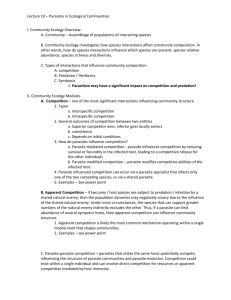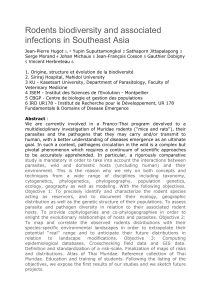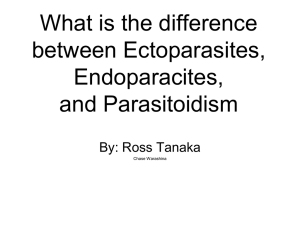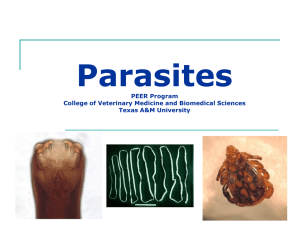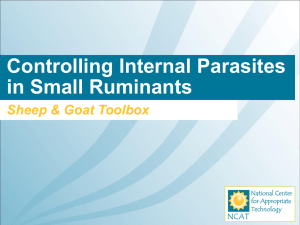Parasites as prey
advertisement
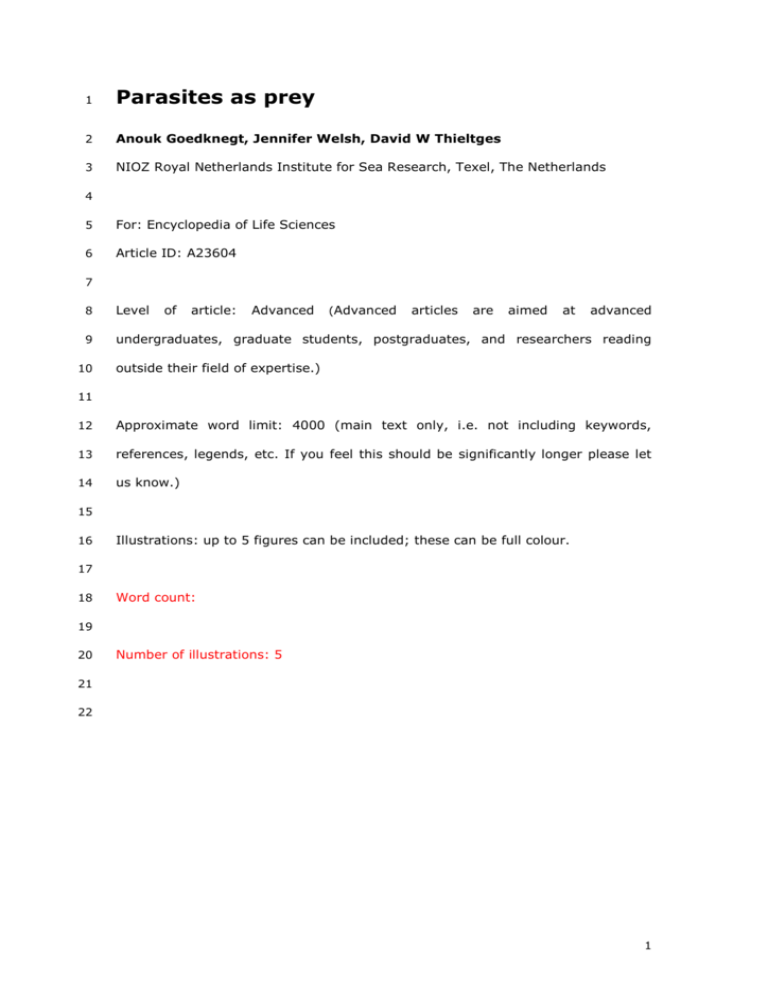
1 Parasites as prey 2 Anouk Goedknegt, Jennifer Welsh, David W Thieltges 3 NIOZ Royal Netherlands Institute for Sea Research, Texel, The Netherlands 4 5 For: Encyclopedia of Life Sciences 6 Article ID: A23604 7 8 Level 9 undergraduates, graduate students, postgraduates, and researchers reading 10 of article: Advanced (Advanced articles are aimed at advanced outside their field of expertise.) 11 12 Approximate word limit: 4000 (main text only, i.e. not including keywords, 13 references, legends, etc. If you feel this should be significantly longer please let 14 us know.) 15 16 Illustrations: up to 5 figures can be included; these can be full colour. 17 18 Word count: 19 20 Number of illustrations: 5 21 22 1 23 Abstract 24 Parasites are usually considered to use their hosts as a resource for energy. 25 However, there is increasing awareness that parasites can also become a 26 resource themselves and serve as prey for other organisms. Here we describe the 27 various forms of predation on parasites and discuss their relevance for parasite 28 and host populations as well the benifist that parasite predators may gain. 29 30 Article Contents 31 Introduction 32 Predation and transmission 33 Concomitant predation 34 Predation on free-living stages 35 Predation on ectoparasites 36 Parasites as consumers of parasites 37 Summary 38 39 2 40 Introduction 41 In ecological studies, parasites are usually not considered to serve as prey or a 42 resource for other organisms. Instead, by definition, they use other organisms as 43 a resource themselves. However, recent studies on food webs including parasites 44 have shown that parasites are involved in 75% of the trophic links between 45 species, including many links where they serve as a resource themselves 46 (Lafferty, 2006). There are several different ways in which parasites can be 47 involved in trophic links in food webs. First of all, many parasites depend on the 48 predation of their hosts for successful transmission to the succeeding down- 49 stream host , thus hitch-hiking on predation links (trophic transmission). 50 However, not all predators of infected organisms are suitable down-stream hosts 51 and parasites may thus be “accidentally” and indirectly consumed by predators 52 and therefore, not result in a successful transmission. Parasites may also directly 53 become prey during free-living stages of thei complex life cycle. Many species of 54 parasites need multiple hosts to complete their life cycle and include free-living 55 stages to get from one host to the next. In this free-living stage, parasites are 56 extremely vulnerable to predation by non-host predators. Another type of direct 57 predation on parasites involves parasites that attach themselves to the outside of 58 their hosts (ectoparasites). Ectoparasites may also be vulnerable and can be 59 consumed by other animals. Finally, parasites can also serve as prey or host 60 resources for other parasites. In the following, we explain the different cases 61 where parasites become prey and discuss the ecological effects of predation on 62 parasites for the parasites, their hosts and the predators. 63 See also: Here we should add links to other articles in the encyclopedia (at least 64 they asked for it last time). Maybe you can just enter a few links now and leave 65 the rest for later. We will have to revise the draft after the review process anyway 66 and then there will be a good opportunity. These “see also” links could also be 67 added later in the text, e.g. always at the end of a chapter to not mess up the 68 text too much. 3 69 70 Predation and transmission 71 Trophic transmission 72 By definition, parasites are always dependent on the presence of their hosts as all 73 parasites have to transmit from one host to another at some point in their lives. 74 They do so by an infective stage, which is often free-living, whereby the parsite 75 isreleased from a host into the environment., If the parasite has a direct life 76 cycle, the infective stage can infect conspecific hosts or, in the case of parasites 77 with complex life cycles, other hosts. The latter types of parasites often include 78 more than one free-living stage in their life cycle by which the parasites goes 79 through a specific sequence of parasitic stages in hosts and free-living stages. 80 This is illustrated by the typical three-host life cycle of digenan trematodes, a 81 type of parasitic flat worm which are often referred to as ‘flukes’ (Fig. 1). In these 82 trematodes, infection of the next hosts in the life cycle (down-stream hosts) not 83 only occurs via free-living infective stages (definitive host to first intermediate 84 host and first to second intermediate hosts) but also via predation of infected 85 hosts (second intermediate host to definitive hosts). The second intermediate 86 host (up-stream host; a bivalve in Fig. 1) needs to be consumed by the definitive 87 host (the downstream host; a bird in Fig. 1) before the parasite can develop into 88 its adult stage and reproduce. In this life cycle stage, predation of its up-stream 89 host is the only way for the parasite to successfully complete its life cycle. Almost 90 all parasites with complex life cycles follow predator-prey links and depend on 91 trophic transmission at some point in their lives; thus predation and transmission 92 are intricately linked for many parasites (Lafferty et al., 2008). The importance of 93 trophic transmission for parasites is illustrated in a food web from a saltmarsh in 94 California, where a third of the parasite species consumed by predators via their 95 prey use the predator as host (Lafferty et al., 2006). Is this figure really correct? 96 “Concomitant predation” is ONLY predation by non-hosts! 97 4 98 Parasites manipulate hosts to increase transmission 99 [The reviewers might suggest to cut this paragraph as it has nothing really to do 100 with parasites as prey, although it is a nice story. For now, I would leave it in and 101 just wait what they say.] 102 As predation by down-stream hosts is often crucial for the successful transmission 103 of parasites, many parasite species have developed strategies to increase their 104 chances to become transmitted via manipulating the behaviour of their hosts. For 105 example, one trematode species encysts itself in the brain of killifish, an 106 important prey item for birds in the estuaries of California. When a killifish 107 becomes infected, it exhibits behaviours that make it more conspicuous (e.g. 108 surfacing or flashing), making the fish 10-30 times more vulnerable for predation 109 by birds, the definitive host of the parasite (Lafferty and Morris, 1996). Another 110 example is that of the so-called ‘zombie snails’. These snails are infected by a 111 trematode that uses birds as definitive host (Lewis, 1977). When a snail is 112 infected by a parasite egg, the egg transforms/develops into a sporocyst, which 113 contain hundreds of parasitic clones (also called ‘brood-sacs’), which 114 subsequently invade the snail’s tentacles. As the tentacles become more swollen 115 and colourful they start to mimic the appearance of a caterpillar. This alteration to 116 the host caused by the parasite lures birds to eat the tentacles of the snail host 117 and can result in the parasite infecting the bird. The parasite also has another 118 tactic to increase the likelihood of predation by the bird. The infection of the 119 parasite in the tentacles reduces the ability of the snail to react to light intensity. 120 As a result, the snail may no longer hide in the shadow as it would do normally 121 and, therefore, it is more visible for predators.Furthermore, the brood-sacs in the 122 tentacles start to pulsate in response to light intensity (Wesenburg-Lund, 1931), 123 making the resemblance to a caterpillar even more likely. These examples 124 illustrate that parasites can mediate overall predation rates and predator prey 125 choice, depending on the infection levels in a host population. By doing so, they 126 can also affect the flow of energy through a food web. 5 127 128 Concomitant predation 129 Trophic transmission gone wrong 130 Predation of infected hosts does not always lead to a successful transmission. In 131 most cases, the predator will actually be an unsuitable host for the parasite. In 132 this case, the potential (but unsuitable) host acts as a predator, leading to 133 consumption rather than transmission of the parasite (Johnson et al., 2010). In 134 the example of the trematode life cycles (Fig. 1), first or second intermediate 135 hosts as well as the definitive hosts may be preyed on by non-host predators, 136 consuming the parasites together with their prey without becoming infected. This 137 type of accidental predation has been termed concomitant predation (Johnson et 138 al. 2010; black arrows in Fig. 1). For trophically transmitted parasites, this seems 139 like an unavoidable side effect of being dependent on predation links for 140 transmission: whilst predation will sometimes ensure transmission it will probably 141 more often lead to ending up in the wrong host. Interestingly, concomitant 142 predation does not need to lead to the total consumption of the host. For 143 example, one trematode species prevents New Zealand cockles (Austrovenus 144 stutchburyi) from burying in the sediment (via encysting in the cockle’s foot and 145 interfering with the musculature) so that they lay on the sediment surface where 146 they are more vulnerable to predation by birds than their un-infected conspecifics 147 buried in the sediment (Mouritsen and Poulin, 2003). This is usually interpreted 148 as a case of parasite manipulation as the parasite’s down-stream definitive hosts 149 are birds. However, infected cockles on the sediment surface are often not 150 completely eaten by birds (suitable hosts) but partially consumed by benthic 151 fishes (unsuitable hosts): fishes feed on the highly infected tip of the cockles’ 152 feet, a behaviour that is referred to as foot cropping. In manipulative 153 experiments, the scientists found that this partial foot cropping by fish occurs to 154 such an extent that it exceeds total predation by birds. As a result, only 2.5% of 6 155 the parasites are actually transferred to their down-stream hosts, while 17.1% 156 are lost to the fish (Mouritsen and Poulin, 2003; Fig. 2). 157 158 Increased parasite mortality and changes in prey quality 159 The cockle example illustrates how concomitant predation can significantly 160 contribute to parasite mortality. Food web studies that include parasites suggest 161 that about 63% of the links, where a predator consumes infected hosts, lead to 162 concomitant predation because the predator is an unsuitable host but only about 163 37% of these links result in the transmission of parasites (Lafferty et al 2006, 164 Collinge book chapter). However, to date, little is known on the actual magnitude 165 of concomitant predation on parasite population dynamics. 166 167 For a predator, concomitant predation may result in a food resource with higher 168 nutritional value, specifically when the host is highly infected. However, again, to 169 date there are no studies regarding the potential energy gain that predators get 170 from consuming parasites alongside their actual prey. In contrast, more is known 171 on the effects of parasites on the general energetic value of their hosts. Infected 172 prey may have a reduced or increased quality as a resource for predators, 173 depending on the parasite-host system. For example, brine shrimps which are 174 infected by tapeworm larvae have a higher energy content compared to 175 uninfected conspecifics (Sánchez et al. 2009). In contrast, fungal infections of 176 Daphnia reduce the energetic value of infected hosts for their juvenile fish 177 predators (Forshay et al. 2008). 178 179 Besides directly affecting the energetic value of their hosts, parasites may also 180 have indirect effects on predation rates of predators. Similar to the host 181 manipulation in trophically transmitted parasites discussed above, parasites may 182 influence predator-prey interactions in non-host predators. They can do so by 183 making their hosts more vulnerable to predation. For example, Daphnia water 7 184 fleas are more likely to be predated on by fish predators when they are infected 185 by a fungi, but the fish do not serve as down-stream hosts (Johnson et al., 2006). 186 As a consequence of the infection, the body cavity of Daphnia is filled with 187 thousands of dark sporangia, reducing its transparency and making it more 188 visible for fish predators. Another example of how parasites can influence 189 predator-prey interactions is the case of the shell-boring polychaete Polydora 190 ciliata. This worm weakens the shell of the marine periwinkle Littorina littorea, 191 making infected snails more vulnerable to predators. Interestingly, shore crabs 192 make use of this weakness, preferring infected snails over uninfected snails 193 (Buschbaum et al., 2007). 194 195 Predation on free-living stages 196 Vulnerable life cycle stage 197 As discussed above, some parasites have life cycle stages which occur in a host 198 and other stages whereby the parasite is living freely in the environment (Fig. 1). 199 Once outside the protection of a host, these free-living stages are vulnerable to 200 various abiotic and biotic factors (for abiotic examples: Pietrock & Marcogliese; 201 Thieltges et al., 2008). For example, surrounding organisms can prey upon the 202 free-living stages, thereby reducing them in numbers. Some predators prey 203 actively on these free-living stages such as juvenile crab and shrimp, while others 204 predate in a more passive way such as filter feeders. As a result, the infection 205 levels in the down-stream hosts decrease. This process is called the ‘dilution 206 effect’ and has been reported in many different parasite-host systems (Thieltges 207 et al., 2008a; Johnson & Thieltges 2010). Instead of direct predation, free-living 208 parasites can also be ingested together with a totally different food source. For 209 instance, dung beetles and earth worms frequently ingest eggs and larvae of 210 parasitic nematodes when feeding on faeces of other organisms (English 1979; 211 Waghorn et al., 2002). 212 8 213 Effects on parasites and application in pest control 214 Many studies suggest that the various forms of predation on free-living stages are 215 an important mortality factor for parasites. Predators can, therefore, be very 216 effective in reducing numbers of free-living stages of parasites. For example, 217 copepods can reduce the number of juvenile nematodes [I do not have the paper, 218 is it nematode eggs or larvae and where do they occur?]by 70-100%, depending 219 on the species of copepod and their density (Archinelly et al., 2003). There are 220 many other organisms that have been reported to significantly reduce infective 221 stages of nematodes, either directly or indirectly via ingestion with other food 222 (see Fig. 3 for examples). Similarly, many bivalves like oysters and mussels have 223 been shown to be effective diluters, reducing the number of free-living stages of 224 trematodes by almost 80% (Thieltges et al., 2008b). 225 226 Such strong reductions in the numbers of infective parasite stages have important 227 implications for pest control in agriculture and live stock farming. One example is 228 the reduction of eggs of parasitic nematodes by a nematophagous fungi in the 229 intestines of swines (Ferreira et al., 2011). Normally, the nematodes cause liver 230 damage to the swine (“milk spots” caused by larvae), but the addition of a special 231 fungi to the feed reduced the numbers of eggs by more than 50%. This is 232 because the fungi excreted with the faeces reduce the numbers of eggs on the 233 pasture (Fig. 3). [I am only guessing that this is the mechanism, if not the 234 please correct. The fungi need to consume free-living stages at some point to 235 qualify for this type of parasite predation. If you just give it to the swines like a 236 drug it is not really parasite predation.] 237 238 As free-living stages are usually produced in high numbers, they may also 239 constitute an energy resource for predators preying on them. For example, the 240 production of trematode cercariae in coastal marine systems exceeds the 241 standing stock of birds (Kuris et al. 2008). Many organisms are known to prey on 9 242 cercariae, suggesting that cercariae may be a significant energy source for some 243 predators (Thieltges et al. 2008). However, actual data of the relevance of 244 cercariae in the diet of non-hosts are restricted to juvenile fish in a Californian 245 estuary where predation of cercariae was calculated to comprise approximately 2- 246 3 % of the fishes’ energetic requirements (Kaplan et al. 2009). 247 248 Predation on ectoparasites 249 Grooming and cleaning 250 Another case where parasites become prey is predation on ectoparasites, which 251 are parasites that attach themselves to the outside of the body of a host. A 252 classic example of predation on ectoparasites is grooming by monkeys. In this 253 type of intraspecific interaction, one individual releases a second individual from 254 fleas and other ectoparasites. This is beneficial for the monkey that is groomed, 255 but it also strengthens the social bounding between both individuals. Similar 256 examples are known from interspecific interactions, e.g. from oxpeckers which 257 free mammals on the African savannahs of ticks (Grutter, 1999) and from cleaner 258 shrimps and fishes which pick ectoparasites from fish hosts (Fry et al., 2000). 259 260 Effects on parasites, hosts and predators 261 For parasites, grooming and cleaning are probably often significant sources of 262 mortality, with negative effects on parasite population dynamics. In contrast, 263 grooming and cleaning are beneficial for both, the host and the predator: one 264 species profits from the energy resource and the other species is released from its 265 parasite pressure. Hence, this type of interaction can be considered to be 266 mutualistic. The benefit for hosts can be illustrated in the case of cleaner fish that 267 that feed on ectoparasites attached to the body of their clients. When these 268 cleaner fish are absent over a longer period the hosts are negatively influenced by 269 the ectoparasites. In a study over a 8.5 year period, Grutter et al. (2011a) found 270 significantly smaller hosts in an area where no cleaner fish were present, 10 271 suggesting that these hosts had to investigate their energy in their immune 272 system rather than into growth (Grutter et al., 2011a). In addition, in the 273 absence of cleaner fish, a reduction of 65% in visiting juvenile hosts was 274 observed. The juveniles suffer from the absence of cleaner fish, as the 275 ectoparasites have a negative influence in their performance as measured by 276 swimming and oxygen consumption (Grutter et al., 2011b). The cleaning 277 symbiosis is also very beneficial for the cleaners as ectoparasites may constitute 278 a large part of their diet (Grutter 1996). 279 280 Cleaner fish in aquaculture 281 Ectoparasites can be a significant problem in aquaculture, where high stocking 282 densities often provide ideal habitats for the parasites. A prominent example is 283 ectoparasitic salmon lice (a copepod), which feed on the fish tissue and can cause 284 morbidity and mortality (Pike and Wasworth, 1999; Fig. 4a). When a population 285 of lice settles in thesea cages, where the salmon are raised (Fig. 4b), the 286 parasites can spread easily due to a free-living life stage and the high densities in 287 which the fish are kept, resulting in declines of salmon stocks in the cages 288 [correct addition?] (Conners et al., 2010). Even more worrying is the fact that the 289 free-living stages of the parasite can also spillover and infect wild populations of 290 salmon, (Costello, 2009). This spill-over can cause up over 80% mortality in 291 many runs of wild pink salmon, which frequently pass salmon farms on their way 292 to the open ocean (Krkošek et al., 2007). Since salmon lice are such a problem, 293 various treatments have been tested; however these compounds often have 294 undesired effects on the fish or the environment (Roth et al., 1993). As an 295 alternative, it has been suggested to add cleaner fish or shrimp into the net pens 296 to reduce ectoparasite burden of the fish (Figure 4c). For example, scientists 297 introduced two species of cleaner fish on two Irish salmon farms (Deady et al., 298 1995). By using a ratio of one cleaner fish to 250 salmon, the lice levels were 299 kept below five lice per fish. In addition, the salmon were less stressed by this 11 300 type of pest control than conventional chemical treatments. Furthermore, there 301 are two species of cleaner shrimps that inhabit North-Atlantic shallow waters and 302 remove ectoparasites from plaice (Östlund-Nilssen et al., 2005). These results 303 suggest that cleaner shrimps and cleaner fish could be suitable as biological 304 control agents for sea lice infections on salmon and other fish in aquaculture 305 settings. 306 307 Parasites as consumers of parasites 308 Hyperparasitism and intraguild predation 309 Finally, parasites can serve as a resource for other parasites, either by being 310 parasitized by other parasites (hyperparasitism) or by being preyed by other 311 parasites (intraguild predation). The first happens when a parasite infects another 312 parasite. This is particularly well demonstrated within an order of Hymenoptera 313 insects . These so-called hyperparasitoids often infect a primary parasitoid, which 314 in turn infects a herbivorous or scavenger host (Sullivan and Völkl, 1999). The 315 second happens when parasites kill and consume other parasites, often in order 316 to get rid of potential competitors. For example, trematodes infecting snails as 317 first intermediate host can be preyed on by other species of trematodes. Some of 318 these predating species develop a special cast of small ‘soldier morphs’ with large 319 mouths for this purpose. These ‘warrior’ worms attack other parasites trying to 320 invade the snail host. Another morph of large worms acts as reproductive cast 321 worms (Hechinger et al., 2011). Both morphotypes (?) are genetically identical as 322 they are clones derived from a single miracidium infecting the host snail. Hence, 323 this shows an analogy to the social organisation in colonies of ants or bees. 324 325 Hyperparasitism and pest control 326 The significant effect of hyperparasites on their hosts is illustrated by the effective 327 use of insect hyperparasitoids as biological control agents against pest insects in 328 agriculture. Here, they can be very efficient in controlling pest populations. 12 329 However, there are also cases where hyperparasites can infect the ‘good’ parasite 330 that was initially introduced for pest control. For example, a non-indigenous wasp 331 of the order Hymenoptera is used to protect cassave plants from the South 332 American mealybug in Africa (Herren and Neuenschwander, 1991; Fig. 5). The 333 original infection success of the wasp was so high that even the defence 334 mechanisms of the mealybugdid not stop the biological control (Sullivan and 335 Neuenschwander, 1988). However, the presence of the new wasp got attention 336 from at least ten native species of hyperparasitoids. They infect the introduced 337 control agent in occasional but very high levels despite, on average, having no 338 detrimental effect on the control efficiency (Neuenschwander, 1996). 339 340 Summary 341 The examples above demonstrate that there are numerous ways of how parasites 342 can act as prey for other organisms: via predation of non-hosts on infected hosts 343 (concomitant predation) or predation of free-living stages, via predation on 344 ectoparasites in form of grooming or cleaning or by serving as prey (or host) for 345 other parasites. In many cases, these types of predation significantly reduce the 346 numbers of parasites and thus affect parasite population dynamics. In contrast, 347 predation on parasites is often beneficial for the hosts as they are released from 348 parasite burden. Finally, when parasites act as prey they may contribute to the 349 non-host predator’s diet, in some cases constituting a significant proportion of the 350 diet. Integrating the different types of predation on parasite as trophic links in 351 food webs indicates that such predation is very common. Studying the strength of 352 these links in future studies will increase our understanding of disease dynamics 353 as well as the topology and functioning of food webs. 354 355 13 356 References 357 Add complete reference list here 358 Check that references in the text match the references in the reference section 359 Make sure formatting is uniform 360 Check ELS Author Guidelines for their formatting requirements 361 362 Sánchez, M.I. et al. (2009) Neurological and physiology disorders in 363 Artemia harboring manipulative cestodes. J. Parasitol. 95, 20–24 364 365 Grutter, A.S. (1996) Parasite removal rates by the cleaner wrasse 366 Labroides dimidiatus. Mar. Ecol. Prog. Ser. 130, 61–70 367 368 Forshay, K.J. et al. (2008) Festering food: chytridiomycete pathogen 369 reduces quality of Daphnia host as a food resource. Ecology 89, 2692– 370 2699 371 372 Kaplan, A.T. et al. (2009) Small estuarine fishes feed on large 373 trematode cercariae: lab and field observations. J. Parasitol. 95, 374 477–480 375 376 Further reading 377 Any other ideas? 378 379 Johnson, P.T.J., Dobson, A., Lafferty, K.D., Marcogliese, D., Memmott, J., 380 Orlofske, S.A., Poulin, R., Thieltges, D.W. (2010) When parasites become prey: 381 Ecological and epidemiological significance of eating parasites. Trends in Ecology 382 and Evolution 25: 362-371 383 384 14 385 Johnson, P.T.J., Thieltges, D.W. (2010) Diversity, decoys and the dilution effect: 386 how ecological communities affect disease risk. Journal of Experimental Biology 387 213: 961-970 388 389 Thieltges, D.W., Jensen, K.T, Poulin, R. (2008) The role of biotic factors in the 390 transmission of free-living endohelminth stages. Parasitology 135: 407–426 391 392 15 393 [Some figures still need a little fine-tuning, so these are not the final version. I 394 will explain to Anouk in detail what needs to be changed] 395 16 396 397 [Match the final colour in the figure with the one mentioned in legend] 398 Figure 1: Example of a typical three-host life cycle of a trematode, showing the sequence 399 of different hosts and free-living stages involved (thin arrows) and illustrating the different 400 types of predation on them (thick arrows). In this case, the definitive host is a bird, from 401 which the parasites release free-living eggs into the water together with the bird’s faeces. 402 The eggs infect a first intermediate host (a gastropod), in which the parasite reproduces 403 asexually in so-called sporocysts or rediae and releases a second free-ling stage into the 404 water (cercariae). These cercariae infect a second intermediate host (a cockle) in which 405 the parasites encyst (metacercariae). Finally, when the second intermediate host is 406 consumed by the definitive host the life cycle of the parasite is completed. Parasites can 407 become prey either when infected hosts are consumed by non-hosts (concomitant 408 predation; grey thick arrows) or when their free-living stages are consumed (white thick 17 409 arrows). Note that parasite consumption is also an essential part of the parasite’s life cycle 410 when the infected second intermediate host is eaten by the definitive host. 411 [Do you need copyrights for the little drawings?] 412 18 413 414 415 Figure 2: Partial predation on infected hosts by a non-host predator. A 416 trematode species infecting the New Zealand cockle impairs its burying ability so 417 that cockles are exposed on the sediment, resulting in an increased predation by 418 the definitive host compared to uninfected conspecifics . However, fish also 419 partially prey on exposed infected cockles by nipping off the tip of the cockles’ 420 foot. Most parasites are concentrated in the foot tip and, since the fishes do not 421 serve as down-stream hosts, a significant proportion of the parasites are lost via 422 this concomitant predation. 423 19 424 425 426 [Are my additions below correct?] 427 Figure 3: Examples of the levels of reduction of infective free-living stages of parasitic 428 nematodes by various organisms from different systems: earth worms (Grønvold, 1987; 429 Waghorn et al., 2002) and dung beetles (English, 1979) preying on nematode eggs and 430 larvae in dung, copepods preying on [what and where?] (Archinelly et al., 2003), mites 431 [what and where?] (Karagoz et al., 2007) and nematophagous funghi on nematode larvae 432 on livestock pasture (Ferreira et al., 2011). 433 [Do you need copyrights for the little drawings?] 434 435 20 436 437 438 Figure 4: Typical ectoparasites of salmon in aquaculture and their consumption by cleaner 439 fishes: a) salmon lice (parasitic copepods, the brown ectoparasites) infect salmon and 440 cause damage to the skin, often leading to secondary infections (Copyright of Colin 441 Kirkpatrick), b) salmon farm, where the high stocking densities are ideal habitats for the 442 transmission of the copepods (with a direct life cycle) from one host to another (Copyright 443 of The Atlantic Salmon Trust) an c) a cod with a cleaner fish, preying on ectoparasites like 444 copepods (Copyright of A. Grutter). 445 21 446 447 448 Figure 5: Example of a parasitoid, introduced to control a plant pest, which then became 449 host to native parasitoids, thus becoming hyperparasitoids. The cassava plant is defoliated 450 by the South American mealybug, an unwanted herbivore. As a control for this pest, a 451 parasitoid from the order Hymenoptera was introduced. This parasitoid, in turn, was 452 exploited by 10 native species of parasitoids. 453 [Do you need copyrights here?] 22

